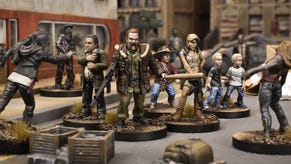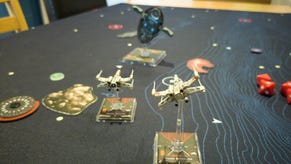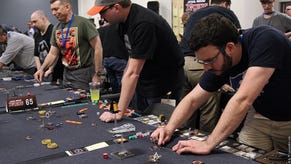7 best skirmish games for small-scale wargaming
Close combat.
What are the best skirmish games, and why should you care? Would you like to play a fun game where nifty models do awesome violence at each other in a fantastical setting? A game where your devious strategies and whip-smart tactics are the only thing between your team of war-friendos having a delicious victory muffin by the fireside and demoralising defeat at the greasy hands of your undeserving opponent? Of course you would. Well, simply grab your modest force of 200 fully-painted, customised battle lads and plonk them down on the huge table we assume you have in the center of every single room in your house. Also, your house is made of range rulers and all your children’s faces are giant polyhedral dice.
What’s that you say? These are silly demands to make of someone who just wants to enjoy an hour or so of dicey shoot-shoot before returning to other aspects of their life that don’t involve either dice or shooting? Actually, yes, fair enough. There is another option, though. They’re called skirmish games, and we literally just invented them for this list.
Best skirmish games
- Battletech: Big mechs. Crunchy rules. Decades of lore.
- Wasteland Warfare: Dynamic, immediate Fallout-themed tactics.
- Drowned Earth: Dinosaurs, gorillas and… pandas duke it out in verdant post-apocalyptica.
- X-Wing Miniatures Game: Ships, in space, doing a war.
- Warhammer: Underworlds: Warhammer Fantasy in its most accessible format.
- Arena Rex: Mythology-tinged gladiatorial combat.
- Company of Iron: Squad-based skirmishes in the world of Warmachine.
If you’re wondering what a skirmish game is, we could divert responsibility to our list of the best miniatures games that aren’t Warhammer, which included skirmish classics Malifaux and Frostgrave, and then say “games like those”. Generally, though, skirmish games stand out for having few models, with more nuanced rules for each. Crack teams of commandos, rather than disciplined phalanxes of troops.
The cash, space and time-saving potential of skirmish games are all major plusses, but what’s extra lovely about them is how they can free up hobbying time. When you only have to focus on a handful of table-ready miniatures, you can give each one the TLC they deserve, resulting in squads that are small on table space but big on character. All that said, here are a few of the best skirmish games out there.
1. Battletech
Big mechs. Crunchy rules. Decades of lore.
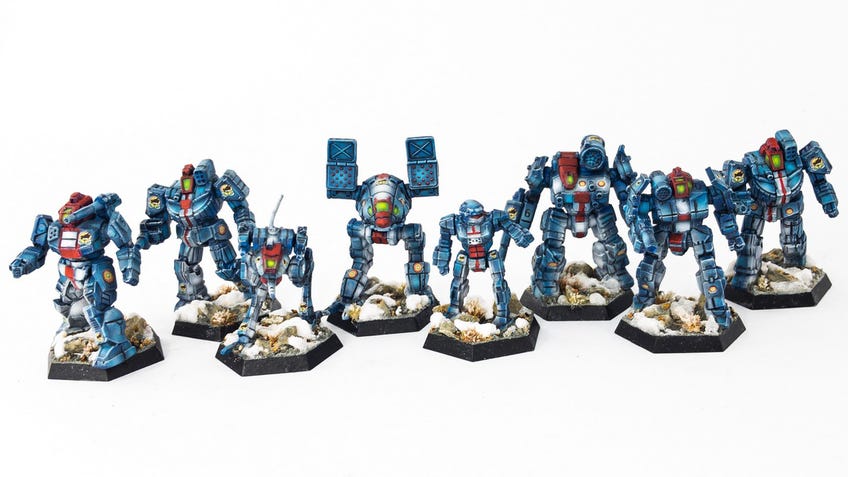
For a game about giant robots, Battletech is a masterclass in how to pack a lot into a little, offering a huge amount of tactical depth with very few moving parts. Each ‘lance’ may only have three or four Battlemechs, but each ‘mech is more mobile fortress than footsoldier, with more rules for how each of its individual legs work than some entire squadrons in other games.
If this sounds daunting… well, yes. It absolutely can be for the first few games or so. Battletech takes place in a rich sci-fi setting fleshed out over decades of lore, and bolsters this through rules that are as much about thematics as tactics. As a result, it features a lot of intricate systems designed to simulate the inner-workings of each battlemech. These mechs feel heavy, they feel resilient, and yet, they still feel vulnerable when faced off against equally-matched opponents.
This means matches unfold as stories as much as strategic head-to-heads. Much like, say, the body-part wound dice of Kingdom Death: Monster or the traits of Darkest Dungeon can result in odd, dramatic personal stories arising from systems reacting against each other, Battletech’s ‘paper doll’ mech damage tables work to bring strategy and theme together.
Battletech has the distinction of being one of the cheapest skirmish games on this list to get started with. The “Game of Armoured Combat” starter set not only contains a roster of plastic mechs, but some serious additional tonnage in cardboard standees. A game company actively offering alternatives to buying more miniatures almost feels like breaking the law, but here we are. This means it’ll be awhile before you need to seek out extras. Once you do feel like branching out, though, there’s plenty of supplementary materials available - from expansions and novels to full-on RPG systems.
Buy Battletech Beginner Box on Fantasy Welt and Amazon US.
2. Fallout: Wasteland Warfare
Dynamic, immediate Fallout-themed tactics.
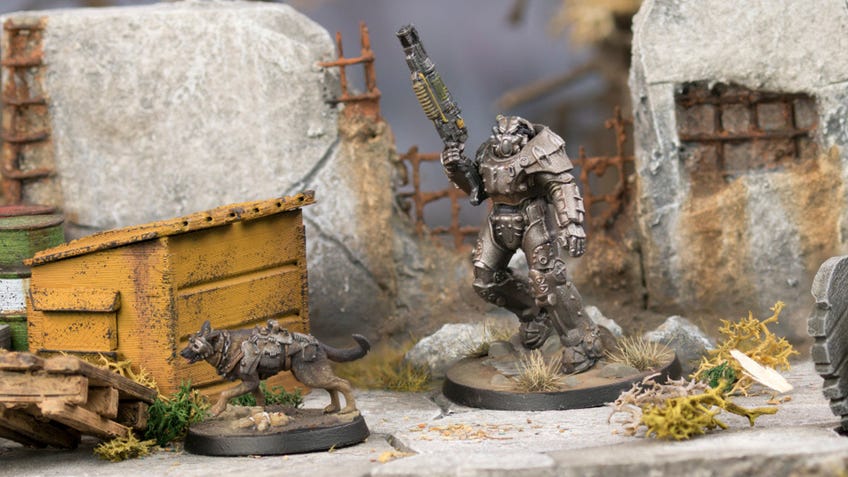
Fallout: Wasteland Warfare’s combat is far closer to Fallout 1 and 2 than anything from the later video games in the series. This sentence may just instill you with a warm sense of nostalgia, or perhaps memories of extreme frustration. Neither of these feelings would be entirely unjustified. Wasteland Warfare comes very close to the same turn-based, stat-reliant combat you remember from those classic video games, although it can also be prone to fiddly periods of inaction and a few too many moving parts. Still, it’s the Fallout series’ most successful and interesting tabletop adaption, and works great with just a handful of models on either side.
The game is based around the S.P.E.C.I.A.L system. That’s Strength, Perception, Endurance, Charisma, Intelligence, Agility and Luck. Success comes from rolling dice lower or equal to stats that correspond to your current action, with additional modifier dice based on things like attack type, range and cover.
Ranged weapons have different effects, depending on how close the attacker is to their target, so positioning is important. A ‘quick action’ system allows for reactions, like taking overwatch shots on your opponent’s turn. There’s also a overarching risk/reward mechanism in the way the turn order can be interrupted and manipulated by readying multiple models for synchronised actions.
There’s also a whole vault’s worth of different ways to play. The basic skirmish rules are downloadable for free, but there’s also narrative and campaign play. There’s even an AI system for solo and cooperative play. Who knew the wasteland could be so hospitable!
Buy Fallout: Wasteland Warfare Starter Set on Amazon UK and Amazon US.
3. The Drowned Earth
Dinosaurs, gorillas and… pandas duke it out in verdant post-apocalyptica.
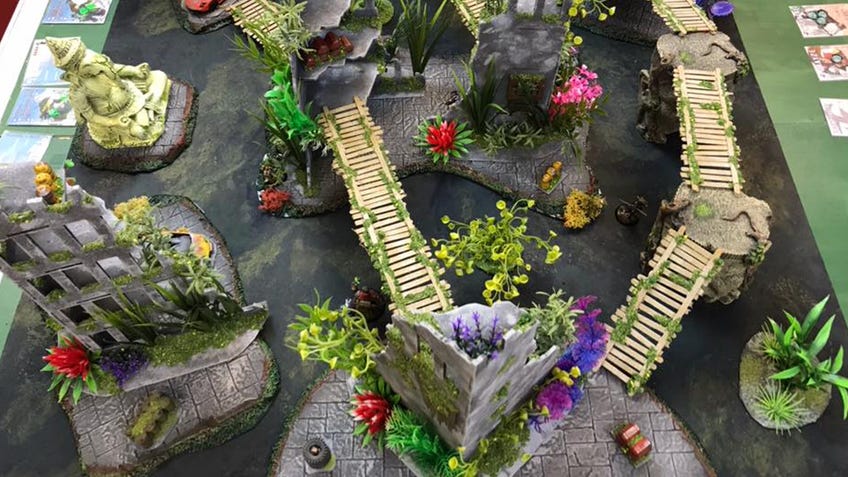
Interested in cyborg monkeys fighting dinosaurs? A rhetorical question, obviously. A quick look at the highly creative models is enough to immediately tell you whether you're into The Drowned Earth’s verdant post apocalyptia and menagerie of warring factions. If you are, you’ll soon find there’s very little else like it.
The Drowned Earth uses a lot of systems you might traditionally find in a tabletop RPG to give each of the five-or-so models on each side some real character. It’s very terrain dependent - which might be a downside for some - and uses stats like agility to govern dynamic movement like climbing, leaping and even having gunfights in mid-air. Plus, different unit archetypes like scout or medic mean clear tactical utility and differentiation in your squad, plus some fore-knowledge of what your opponent’s team is capable of.
Players can declare reactions to each other's moves - like in the aforementioned mid-air gunfights - and combined with the agility manoeuvres, these skirmishes between space elephants and velociraptors can soon get pretty John Wick-esque. God, I’m glad I got to write that last sentence.
Experienced wargamers will recognise elements like model-dependent line-of-sight, range-measuring and scatter templates, but easily accessible stat cards means that Drowned Earth still feels very compact.
Buy The Drowned Earth on the game's website.
4. X-Wing Miniatures Game
Ships, in space, doing a war.
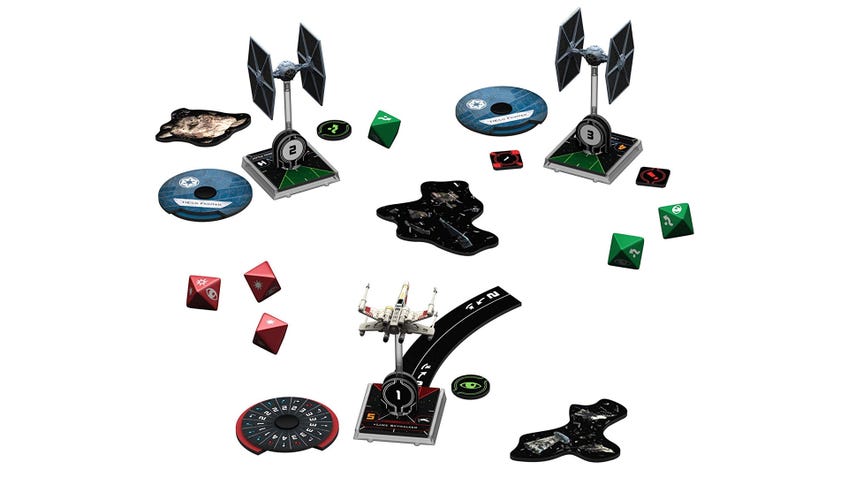
The X-Wing Miniatures Game is a theoretical skirmish game, in that it is definitely a skirmish game that will stay a skirmish game if you can theoretically stop yourself buying an entire fleet's worth of ships. Your own capacity to resist funnelling your savings into tabletop giant Asmodee’s coffers notwithstanding, X-Wing works wonderfully with just a few models on either side.
As anyone who's ever taught the game will tell you, there’s something about X-Wing that manages to grip and delight even inexperienced gamers, and much of this is down to how its interstellar stand-offs rely on psychology just as much as strategy. Each player pre-selects their flight paths in secret, then resolves them in an initiative order. This not only solves the issue of one player sitting back for an age while the player who won an initiative roll wipes out half their force, but adds a wonderful thematic dynamism to dogfights.
Now on its second edition, 2.0 made a host of improvements to model quality, as well as ironing out a lot of rough edges and shaking up what had become quite a predictable competitive meta. It’s also an absolute steal to get into for a licensed miniatures game, at under 30 quid for a starter you can easily go halves on with another prospective star pilot.
Buy Star Wars: X-Wing Miniatures Game on Amazon UK and Amazon US.
5. Warhammer Underworlds
Warhammer Fantasy in its most accessible format
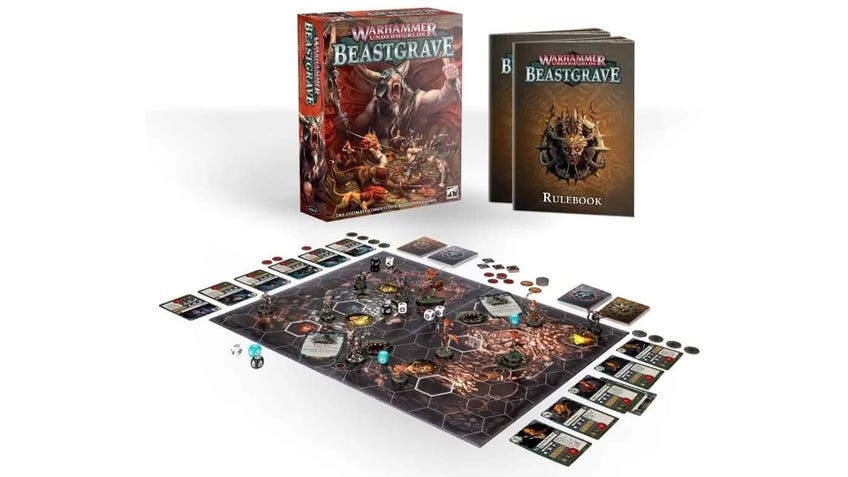
It’s hard to keep up with absolutely everything Games Workshop has put out since the company made a big push toward board games and snack-sized offerings, so there might be a bit of hyperbole in this next, highly subjective statement, but here goes: Underworlds is the most well-designed miniatures game that Games Workshop sells.
The game combines elements of deckbuilding, secret objective cards, area control, spell and ability-casting into something that feels incredibly rich but still accessible. There’s still dice, sure, but with so many options for mitigation and setup, random rolls rarely feel like the crux of the experience.
It’s all hex-based, too, which makes it a great gateway between board gaming and traditional range-ruler based wargames. Not for nothing, either, as tactical play is just as often about repositioning your opponent’s pieces as doing damage - adjacent friendly figures can bolster each other in combat. Again, positioning often mitigates bad dice rolls, making forethought far more valuable than dumb luck.
With so many elements, a lesser game could end up being unwieldy, but Underworlds stays incredibly sleek and streamlined throughout with clear progression based on phases.
An honorable mention here should also go to Necromunda. While Warhammer Underworlds adapts some basic Games Workshop miniatures concepts into a tactical board game, Necromunda is a far more traditional Warhammer experience, albeit on a much smaller scale, featuring a ton of extra-crunchy customisation options and a far-future theme.
Buy Warhammer Underworlds: Beastgrave set on Amazon UK and Amazon US.
6. Arena Rex
Mythology-tinged gladiatorial combat.
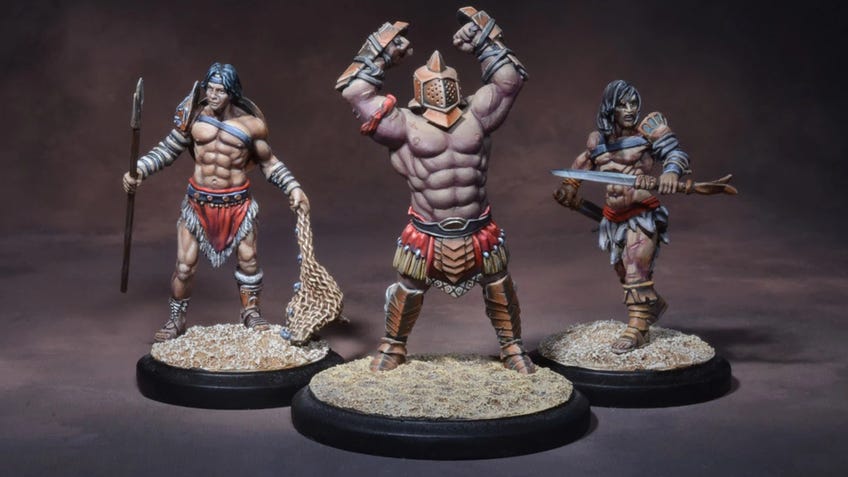
With its gladiatorial combatants duking it out in the arenas of antiquity, Arena Rex seems like such a rich theme for a skirmish game it’s surprising there haven’t been more imitators. One is enough, in this case, as Arena Rex is a wonderfully original, thematic and elegant miniatures game that absolutely gets the thumbs up. Or, like, to one side if you want to be a stickler about history.
Keeping with the theme, players have access to a resource called ‘favour’ - essentially, how much the crowd is feeling your performance - which can be used to modify dice rolls. Favour can be earned by - how else - spilling more blood in the arena. A fatigue system also plays heavily into combat, meaning players will need to plan how far they want to push their combatants.
Painters worrying that gladiators with a few lions thrown in might be a bit of a dull undertaking need not fear, either. Arena Rex straddles the line between history and mythological fan-fiction. Gladiators riding giant komodo dragons and scorpion riders make an appearance, as do gorgons and sea monsters. Even if neither side chooses to bring these mythical creatures, they can still be used as ‘Living Hazards’, adding some chaos to matches. Fantastic beasts aside though, even the basic three-person teams are incredibly detailed and characterful.
Buy Arena Rex from the game's official website.
7. Company of Iron
Squad-based skirmishes in the world of Warmachine.

This one’s a bit of an honourable mention, as it gives us some space to talk about other, similar formats. Namely, scaled-down versions of traditionally larger miniatures games. Company of Iron is a teensier game mode for Privateer Press’s Warmachine/Hordes range, focusing mainly on squads of infantry, changing things up significantly from the special unit-focused Warmachine/Hordes.
The starter box is a teensy bit hard to come by, but if you already have some Warmachine models and paraphernalia, here’s a free PDF of the ruleset. If you’re in the market for a similar format, though, there’s also Battletech’s Alpha Strike, Infinity’s Recon, or Warhammer 40,000’s Kill Team. They all follow the same basic principles: A streamlined, more and time effective experience, with tailored rules that keep things focused and interesting.
Buy Company of Iron from Privateer Press.



